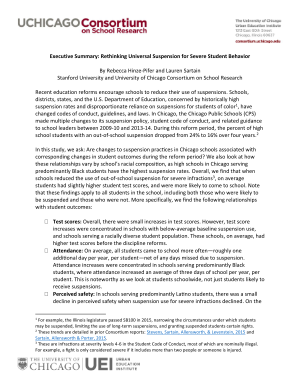1. Are changes to suspension practices in Chicago schools associated with corresponding changes in student outcomes during the reform period?
Recent education reforms encourage schools to reduce their use of suspensions. Schools, districts, states, and the U.S. Department of Education, concerned by historically high suspension rates and disproportionate reliance on suspensions for students of color, have changed codes of conduct, guidelines, and laws. In Chicago, the Chicago Public Schools (CPS) made multiple changes to its suspension policy, student code of conduct, and related guidance to school leaders between 2009-10 and 2013-14. During this reform period, the percent of high school students with an out-of-school suspension dropped from 24 percent to 16 percent over four years.
In this study, we ask: Are changes to suspension practices in Chicago schools associated with corresponding changes in student outcomes during the reform period? We also look at how these relationships vary by school’s racial composition, as high schools in Chicago serving predominantly Black students have the highest suspension rates.
Overall, we find that when schools reduced the use of out-of-school suspension for severe infractions, on average students had slightly higher student test scores, and were more likely to come to school.
Additionally, students at the highest estimated risk of suspension felt safer in their schools when suspensions for severe infractions were reduced. Students at the lowest estimated risk of suspension, meanwhile, saw the largest test score gains. We do not find evidence that, overall, students’ academic achievement was harmed by the policy changes.
This study challenges the assumption that severe infractions should trigger automatic suspensions. In CPS high schools, reducing the use of suspensions for severe infractions was not associated with declines in student safety. Some students felt safer, and the policy may have even made students better off in terms of test scores and attendance. However, it is important for districts to consider what supports schools, administrators, and teachers need when the use of suspensions is curbed. For example, administrators may need support to create school-wide culture changes and protocols, and teachers may need resources related to managing classroom behaviors or trauma-informed instructional practices in order to better support the needs of all of their students. Further, implementing more restorative approaches to addressing student misbehavior and conflict is hard work and requires resources in terms of training and staff. Thinking through all of the potential implications of rolling back suspensions is a critical component in supporting the work of schools.


